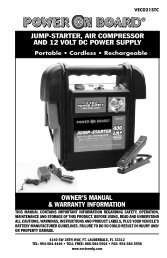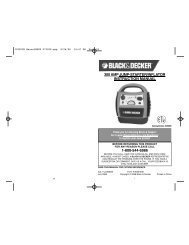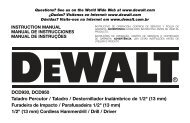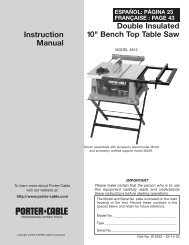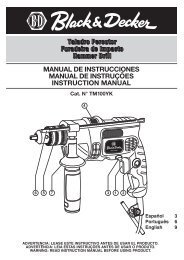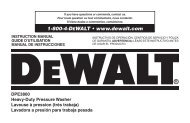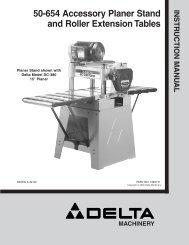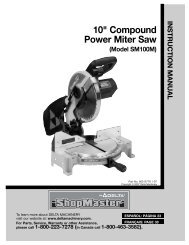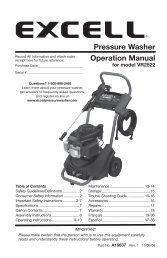90528012 BDMS200 miter saw
90528012 BDMS200 miter saw
90528012 BDMS200 miter saw
Create successful ePaper yourself
Turn your PDF publications into a flip-book with our unique Google optimized e-Paper software.
3. To adjust, loosen the locknut (B) Fig. 25, and turn the screw (C)until the head of the screw (C) contacts the casting (D) whenblade is 90° degrees to the table. Tighten the locknut (B).4. Loosen the bevel lock handle. Move the cutting arm all the wayto the left bevel position and tighten the bevel lock handle.5. Use a combination square (A) Fig. 26 to see if the blade is at 45°to the table.6. To adjust, loosen the locknut (E) Fig. 27, and turn the screw (F)until it contacts the casting (G). Tighten the locknut (E).7. Check to see that the bevel pointer (P) Fig. 28 is pointing to the45° mark on the bevel scale (S) Fig. 26. To adjust the bevelpointer (P) Fig. 28, loosen the screw (H) and adjust pointer (P).Tighten the screw (H) securely.8. These positive stops enable you to rapidly position the blade atthe 90° and 45° bevel angle to the table.ADJUSTING THE TENSION OF THE CUTTINGHEAD RETURNSPRINGWARNING: CUTTING HEAD MUST RETURN QUICKLY TO THEUP POSITION. DISCONNECT MACHINE FROM POWER SOURCE.The tension of the cuttinghead return spring was adjusted at thefactory so that the cuttinghead returns to the "up" position aftercutting.To adjust the spring tension, loosen the locknut (A) Fig. 29 and turnthe screw (B) (clockwise to increase or counterclockwise to decreasethe spring tension). After adjustment, tighten the locknut (A).ADJUSTING SLIDING FIT BETWEEN CUTTINGHEAD ARM ANDTRUNNIONAfter a long period of time, an adjustment of the sliding fit betweenthe cuttinghead arm (B) Fig. 29A, and the trunnion (C) may benecessary. To adjust, turn the nut (D). This adjustment should notbe so tight that it restricts the sliding movement of the cuttingheadarm (B) or so loose that it affects the accuracy of the <strong>saw</strong> cut.ADJUSTING THE LOWER BLADE GUARDWARNING: DISCONNECT THE MACHINE FROM POWERSOURCE.This machine incorporates a blade guard (A) Fig. 29B to cover therear section of the blade. After an extended period of use, themovable lower blade guard may not operate smoothly when thecuttinghead is lowered. This can be corrected by adjusting nut (B)until the lower blade guard moves freely.WARNING: Overtightening the nut could impair guardmovement.NOTE: This unit has been designed with an articulating rear guard.Before contacting the workpiece, the rear guard will rotate upwardto expose more of the blade as the cuttinghead is lowered.WARNING: DO NOT REMOVE ANY OF THE BLADEGUARDS.WARNING: Make sure that all guards are in place andfunctioning properly before operating the <strong>saw</strong>.WARNING: Make sure that the fences are clear of theguard and blade before operating the <strong>saw</strong>.33



